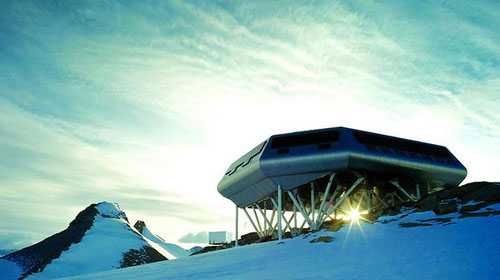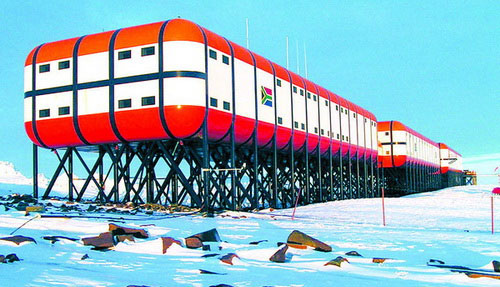Visit the research stations in Antarctica
Since the 1950s, many expeditions from many countries set foot on Antarctica. So far, 53 research stations have been built up here in different positions, different shapes and different purposes.
Here are some typical stations:
1. Princess Elisabeth Station, Belgium

Launched on February 15, 2009, Elisabeth Princess Station is a solid, high-capacity research station, open only in the summer.
The station operates thanks to a complex energy control system, with a 52kWh solar-powered generator and a 54kWh wind power generator.
2. Sanae IV Station, South Africa

Sanae IV is the current research center of the South African Antarctic expedition, completed in 1997.
As the "oldest" research center among the new generation research stations, Sanae IV's position is quite technically disadvantageous: it is about 80km from the edge of the mainland and about 160km from the edge of the South Pole ice block.
However, this location has turned the station into an ideal location for researchers to "detect" sensitive seismic events as well as GPS.
3. Neumayer III Station, Germany

All recently designed Antarctic research stations are located in a tall place and away from the ground, helping them avoid snowstorm attacks when winter comes. Neumayer III station is a typical.
The station was built at a height of 6m above the ground, standing firmly thanks to 16 very strong legs. The legs are arranged on a solid snow surface, and the technical equipment is brought into a snow cave in front of the station.
4. Halley VI Station, England

Halley VI is a Antarctic research station with a long history: scientists have worked here for 54 years. The ozone layer hole was first discovered here.
Monitoring of atmospheric status requires a stable observation site. However, it is difficult to achieve this because the Antarctic ice sheet is always moving, so the old Halley station was abandoned to build a new station.
The new Halley station looks like a giant camping car. When the ice block moves, the wheels will pull the station back to its original position instead of following the ice block.
5. Concordia Station, France-Italy

Concordia Station operated in 2005, at an altitude of 3,233m above sea level at a position called Dome C on the Antarctic plateau.
Concordia is a fixed and active third research station throughout the year in the Antarctic plateau, in addition to Vostok Station (Russia) and Amundsen-Scott (USA), run by French and Italian scientists.
6. Amundsen-Scott Station, USA

Amundsen-Scott Station named after the adventurers Roald Amundsen and Robert F. Scott - to the South Pole in December 1911 and January 1912.
As the largest research station located deep in Antarctic territory, it took 12 summer Amundsen-Scott to be completed. It can contain 150 scientists and station keepers.
At first glance, Amundsen-Scott looks like an airplane wing on 35 racks. This design helps the station avoid snow accumulation. If the amount of snow accumulated below the station is too thick, the shelving system can lift the entire station at the same height as the second floor of a building.
Source: Xinhua
- China built two more research stations in Antarctica
- Chinese research station in Antarctica
- Antarctic Scientific Research Center
- China built the third scientific research station in Antarctica
- China is about to build two Antarctic research stations
- China will build its fifth research station in Antarctica
- Using clean energy in Antarctica
- Japan plans to build a new research station in Antarctica
- China inaugurated a new research station in Antarctica
- 13 splendid train stations like the palace in Russia
- South Korea first discovered the meteorite in Antarctica
- India 'race' to Antarctica
 Norway built the world's tallest wooden tower
Norway built the world's tallest wooden tower Kremlin
Kremlin Ashurbanipal: The oldest royal library in the world
Ashurbanipal: The oldest royal library in the world Decoding the thousand-year construction of Qin Shihuang shocked the world
Decoding the thousand-year construction of Qin Shihuang shocked the world